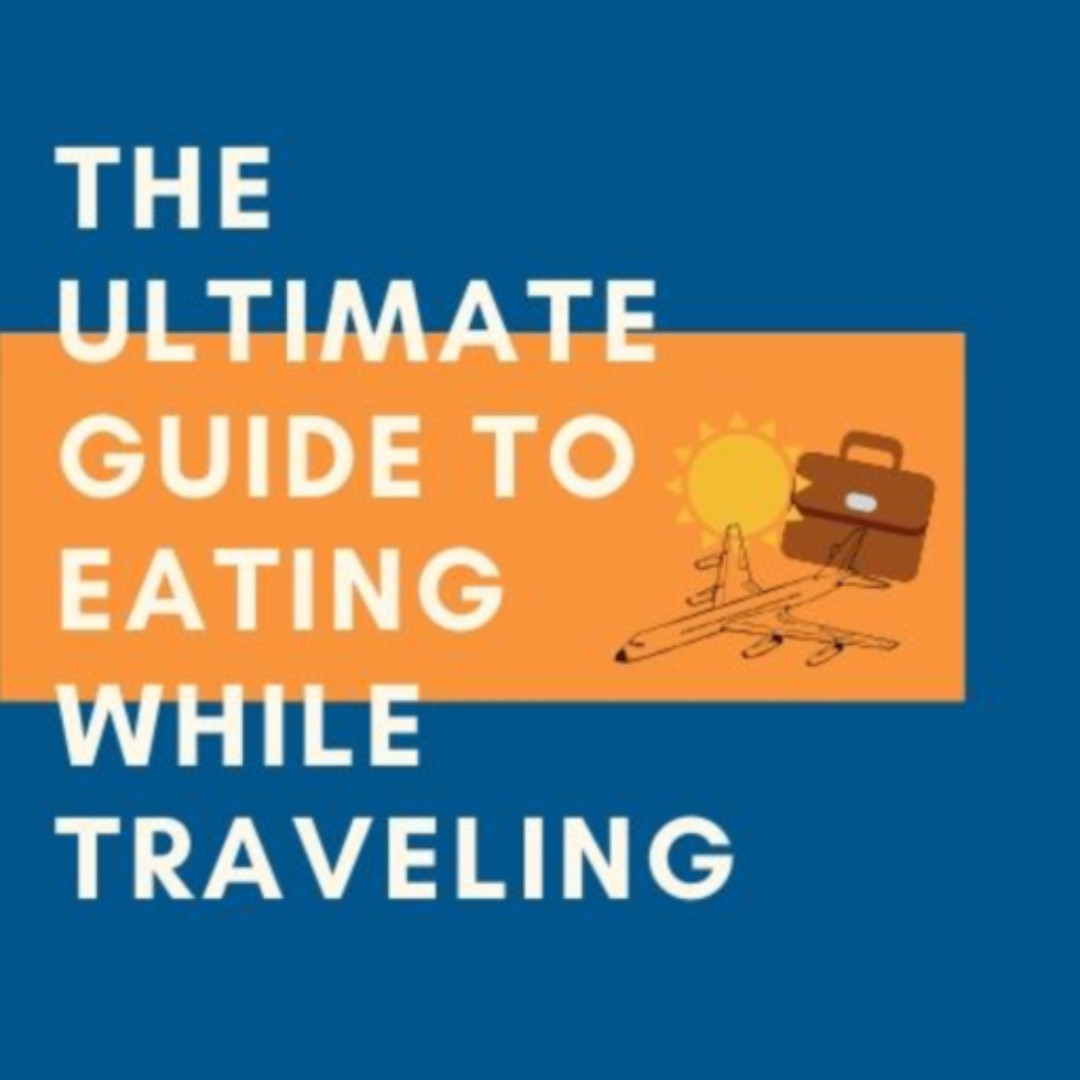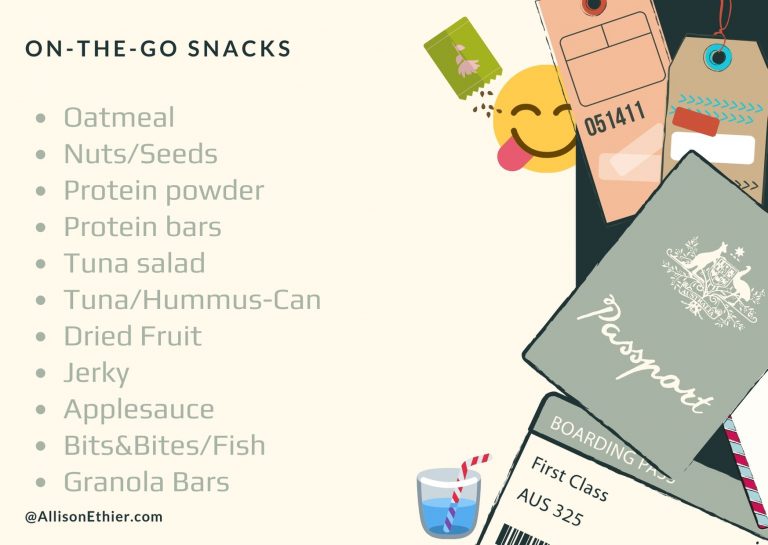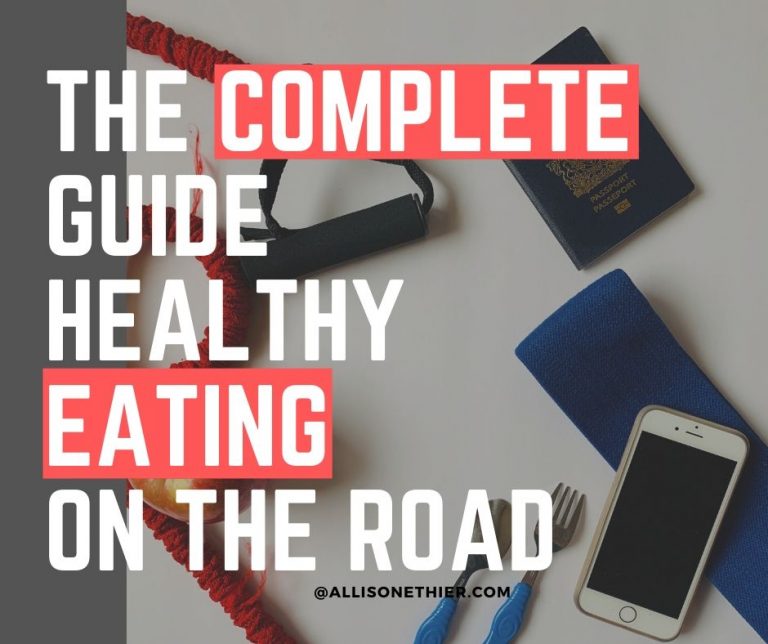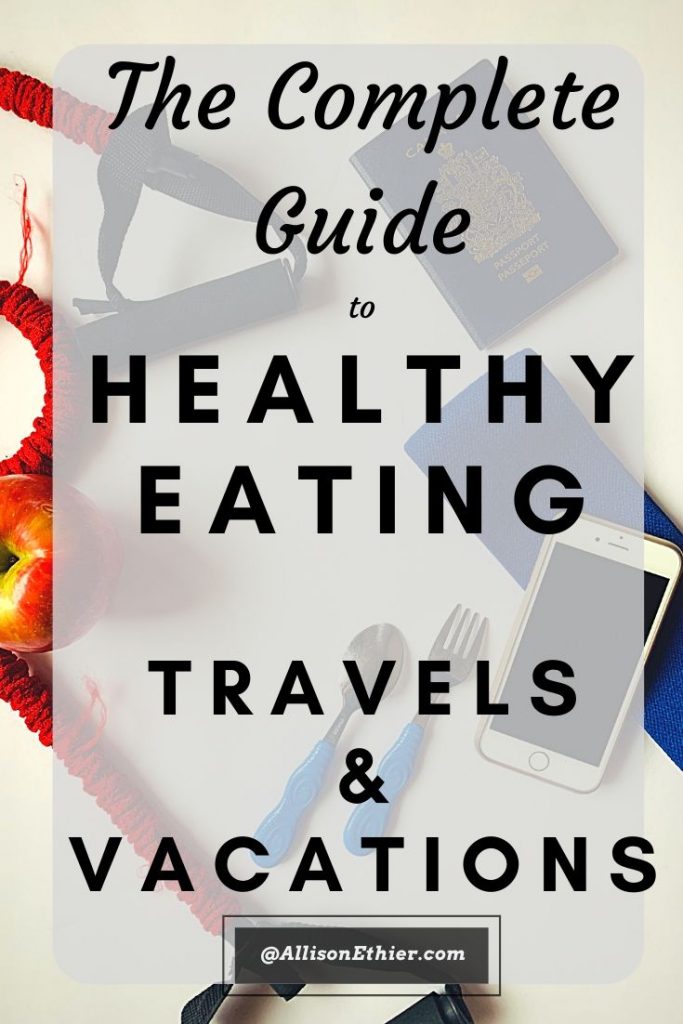Travelling and eating well, can hard but it does not have to be.
When you are out of your environment, off schedule, tired, maybe hungry, and well, slightly cranky from the travel itself, many sights and good smells, can draw you in and off track of your regular mealplan.
Whether it be for weekly travels for work, or just the transfer from home to your vacation destination, here is an ulimate guide, to eating well, traveling with your food, and how to adjust nutritionally, before, during and after you get to your destination.
TABLE OF CONTENTS
- General Guidelines
- Mode of Travel
- Type of Destination – Rental, Resort, Hotel.
- Foods that Travel Well
- Fruits & Vegetables
- At the Grocery
- Kitchen Recommendations
- Eating Strategies
- Workouts & Training
- Summary
PART 1 | GENERAL GUIDELINES
Whether at home or on the road, for any duration of travel, food preparation, is going to be the number one factor in staying on track.
Consider the number of meals, and/or snacks you eat in a day and prepare those meals, in small collapsable cooler to take with you.
If bulk is an issue, consider throw away containers, reuse containers such as yogurt containers, with lids (then recycle them), or ziplock baggies (that you can store away and reuse). That way as you eat, the amount of ‘stuff’ you need to carry becomes less, and your ‘bulk’ becomes lighter.
Food items, that can be cooked, and then frozen can be packed, and used like ice packs until you reach your destination.
If strapping your food to your body does not interest you, just plan for the days meals to bring with you, and use the recommendations listed below on eating in restaurants, or mealplanning considerations, while on the road.
In any event, plan to bring meals good quality meals/snacks for the ride to the airport (mine is at least 2 hours away), and for the duration of your travels, including airport time.
Water will be key to your hydration, and remember to drink regularly. as we tend to forget, during our travels to hydrate ourselves.
Try to limit alcohol while traveling, as it can contribute to dehydration, and also lowers your willpower to make good choices in eating.
If you are flying, the cooler will act as your personal item, or your purse.
TRAVELLING WITH KIDS
Consider what are they going to eat for the day, and bring those appropriate meals and/or snacks. I always over pack, as it is better to have more, than be caught, with a hangry child, in the middle of your travels.
Bring sippy cups & the brushes to clean them, and make sure to have access soap to clean the containers once you arrive.
I made this mistake of being on a resort for a week, with a sippy cup, no brush, no access to soap.
PART 2 | MODE OF TRAVEL
By Car
If you are driving within the country, anything can be taken with you. You can plan for the week’s meals, bring what you can with you, and buy the rest when you get there.
If you are travelling to the US or Internationally – fruits can be brought cross border, but has to be in its original packaging, not bought in bulk.
In order to avoid a situation at the border, I don’t recommend traveling with fruit. Groceries, of those questionable, items can be purchased, after you cross the border.
You can travel with meats, and vegetables if they are COOKED.
By Plane
Carry-On: Here are the rules
Nothing over 3.5oz or 90mL
Nothing that acts like a liquid or gel.
Anything cooked can be taken, including meats, and vegetables.
Other Considerations
International flights don’t like fruit – especially if you are going overseas – even if you buy them after you go through security. Upon arrival you will have to throw it out. You can always try to buy these things, at the airport but be willing to pay for a piece of fruit, or salad, or vegetables. Water is not the only over priced items at the airport. Sometimes you have to go through security and/or customs after you get off the plane in your destination country, and they will take any fruits & vegetables, that you have not consumed.
On the plane you can travel with any foods as long as they are cooked. Liquids need to be less than 3 ounces or 90 mL this is the container size limit. Not the contents. So if you take something that is in a 200 mL container, but only 50mL of it is left – they will take the item at security.
If you choose to take any nut butters you will have to pack them in your suitcase, not on your carry on. Nuts & seeds, can be taken in your carry-on.
No ice packs, they will not allow that and that is over the 3oz/90mL rule.
In general if you have a meal-plan, you can use the structure, the guidelines, and try not to be too distracted by sites, and smells (Cinnabon in the Chicago airport)
Once you reach your destination, if this is the one place you will be staying, it might be a little easier to organize your food, for the week.
If you are in and out of hotels over a period of a number of nights it is essential to remain vigilant, to put your nutrition as the priority as not to get sick, run down, through your travels. Read further down for more suggestions. Vitamins, and protein powders, are pretty easy to travel with, and do not take up a lot of room in your suitcase.
PART 3 | DESTINATION
Cottage/Rental House/Hotel with Kitchenette
Bring anything, and everything you think you possibly might need.
Call ahead, or get a listing of the kitchen equipment available in the house.
Consider your daily kitchen habits, and see if you need anything extra to bring.
Most dry goods, food items, you can bring with you, meals for the ride to your destination, and you can make a grocery shopping list/mealplan as you drive to your destination.
I stayed at a cottage this summer, and make a list of all I used over the week, and you can find it here.
Resort/All-Inclusive
Depending on the type of all package, I would bring a few items just in case.
Breakfast items, like oatmeal, or cereal bars, some snacks, (nuts and dried fruit), snacks for the kids, whey protein to crush your hunger (between meals), are always staples to have on hand, in case, the restaurant, or buffet is closed.
I stayed at one resort that had eating times, which were opposite to our natural schedules for eating – like closed between 1130 -130 and only had pizza, fries, and hamburgers as options in the in between times.
You can always check out the resort, that you will be staying at, to see the menu they are offering for the week, or types of foods (Italian, Japanese, Greek) themed restaurants, or buffets, that they offer, to know in advance.
If you have food allergies, or sensitivies this is also a good idea to research or call ahead, to know that you will be able to have some offerings, and to keep you safe.
Vacation of a Lifetime
International travel such as a glorious trip to Italy or Paris, make sure to bring water/water bottle, some oatmeal/protein powder, and vitamins.
Due to suitcase weight limitations, you might have to prioritize, your packing.
Many of the grocery items, can be purchased, once you reach your destination.
Have a few items on hand, for the day of the travel, plus one other meal.
Delays can happen, and eating at the airport does add up, so if bring as much as you can with you, you can kill two birds with one stone, eat well, and you can save a few $$ for other adventures on your vacation.
Travel for Work
Bring your meals for the day, however, staying in a hotel, means, you either bring kitchen with you. I frequently travel with an electric frying pan.
Else it means ordering in restaurants, or making a quick trip to the grocery store.
Read on, for futher information for restaurants, and groceries recommendations.
Water, vitamins, protein powder, are always good items, to have in your roller bag.
PART 4 | FOODS THAT TRAVEL WELL
The following foods items to consider to bring with you.
You can put in your carry on (remember the liquid issue, if flying), or definitely in your checked luggage.
Oatmeal
Nuts/Seeds
Protein powder
Protein bars
Tuna salad-Oceans
Hummus or Tuna in a can
Jerky – watch the sugar
Applesauce
Bits & bites
Granola Bars
PART 5 | FRUITS & VEGETABLES
Fruits and vegetables, require a special post. If you are driving in country, there is no limit the amount of fruits & vegetables, you can take with you. You can be well, stocked, and well prepared. Or the other option is to buy when you get to your destination.
If you are leaving the country customs, will not allow you to take these things with you by air, or by car.
If the vegetables, are cooked, or if you say they are for the kids -they will allow you to take them.
When filling out the customs form, always mark X under “I have food with me” even if it is a stick of gum.
They are very particular and anything you can possibly eat is considered food.
PART 6 | AT THE GROCERY
Instead of stopping for a burger and fries, just go to the grocery store, for lunch.
Many grocery stores, now have a deli section with a variety of prepared salads, rotisserie or grilled chicken, cut up vegetables, fruits, cheese, and boiled eggs.
These foods may cost a little more, howver, they are good quality, and you can mix & match as needed to create a healthy on-the-go meal.
Meals On-the-Go:
- Tuna/Hummus in a can & Vegetables
- Turkey/Deli meat wraps/Egg salads/Tuna Salad, in pita, or wrap
- Cheese & Fruit/Vegetables
- Nuts/Seeds & Fruits & Vegables
- Fruit & Nuts
- Yogurt & Fruit and/or Nuts/Seeds
- Tuna & crackers – package
- Boiled eggs/Cheese/Vegetables/Fruit
- Dips/Spreads – like hummus, ranch dip, tahini, vegetables/fruits
- Precooked Chicken, or grilled meat of choice, mixed salad, & fruit
- Variety of mixed/prepared salads
PART 7 | KITCHEN RECOMMENDATIONS
Trying to minimize bulk when traveling is one consideration, as you don’t want to be weighed down by your food.
In order of importance, here are some dish recommendations.
If you are travellng to a cottage, or rental, try to ask for a listing of eqiupment they might have, so you can verify if you have everything you need to be as comfortable as possible during your stay. This includes hotels with kitchenettes.
- Shaker cup with lid that is easy to wash/rinse such as these
- Water bottle or buy one water bottle, and reuse it – Contigo is my favorite
- Dish with screw on lid or zip lock baggies – Good for any cut up items, from the grocery or buffet/restaurant
- Knife with sleeve – or ask at the hotel for cutlery
- Fork, spoon, or this utensil kit
- Straws – metal/paper with brush
- Vitamins/Supplements in small containters
Want my summer cottage/kitchenette checklist for a family vacation? See it here (coming soon)
PART 8 | EATING STRATEGIES
Continue to follow your MEAL plan for most of the day. Look at the stucture of the mealplan vs eating that exact food. It will help you see the bigger picture.
Eat a bigger than normal healthy breakfast, later lunch and then for supper allow yourself to have a small treat with every meal which could be bread or a glass of wine or dessert, but not all 3.
Breakfast best choices: Eggs, yogurt, granola, low sugar cereals, protein shake, smoothies, and/or fruits & vegetables.
If you are on business travels you have to consider yourself at home while being on the road. This is not a vacation, but your every day healthy eating. I would follow your mealplan structure as closely as possible.
Lunch Best choices: Lean proteins such as, chicken, fish, seafood, shrimp preferrably grilled, baked or steamed.
Vegetables as a main dish many appetizers are vegetable based, steamed, grilled, stir fry, or large salad with dressing on the side.
It is okay to ask what they put on the steamed vegetables, but request for no butter or oil.
Salads ask for the dressing on the side.
No breads, rice, pasta, as you can have that with your evening meal.
Be leary of the dressings, butter, sauces, and oils. There are a lot of hidden calories, in these items.
Always request on the side, as the restaurants, buffets tend to over do it with oils.
If you order a fattier piece of meat, like salmon, steak, or pork tenderloin the fat is already in the meat, so you do not need to add more butter or oils to your meal.
If shopping at the grocery use the time to discover/try new fruits/vegetables that may not be as economical or available in your area.
Choose leaner cuts of protein such as chicken, fish, pork, eggs, egg whites and dairy.
Supper Best Choices: Lean cuts of meat, steamed vegetables, or large side salad. If you are on vacation, for your supper meal allow yourself to have a small treat with every meal or every second supper meal, which could be bread or a glass of wine or dessert.
If having a fattier cut of meat, I would cut the carbs such as breads, rice and pasta. There tends to be quite a bit of fat in these meats, and depending on how it is prepared could have hiddens fats, like sauces, or oils on it that add up quickly. Cutting the carbs is the trade off for that.
Save the fattier types of proteins such as salmon, steak, trout, ground beef (meatballs, burgers) for once maybe, twice per vacation week.
PART 9 | WORKOUTS AND TRAINING
Before booking your hotel, research if there is a full gym.
What you are looking for is what is offered at your own home gym – weights, cables, cardio equipment, barbells, dumbbells. Or you can do any of my home based workouts, in a hotel room, with minimal equipment.
If your hotel, calls the gym a ‘fitness center’ this needs further exploring as that could be a bike, and few a weights. You have to look online, visit the hotel website, or place of stay and see the photos, read reviews, or call them to ask.
Other possible non-gym activities to keep you active:
Hikes, adventures, swim, walking, rent a bike, explore the city by taking public transit.
The 10 000 steps per day is a good guideline.
In fact, did you know – most phones count your steps without you even having to set anything up – on my iphone under ‘health’ it tracks my steps – as long as I have my phone with me.
Take part in daily actives if on vacation or make moving part of your day.
The app, Around Me, is fantastic to find anything you need, including a gym, or fitness center, by listing those things that are around me.
Before booking you can always make sure, by using google maps. or maps what fitness facilities are located around you.
Walk if you can, any time, vs, taking taxi. or an uber.
PART 10 | SUMMARY
Eat a larger than normal breakfast.
Protein shakes for in between meals.
Bring snacks that travel well, in your carry on.
Drink plenty of water, as travel can be very dehydrating.
Limit alcohol intake
Stay active: aim for 10000 steps per day.
Try to use your eating plan as a structure/check list
Aim to keep your same schedule at home even while on vacation
Whether you are traveling for business, or for pleasure, you do have to remain conscious about your eating choices.
A small 7-day vacation, paired, with large, high carbohydrate, high calorie, high fat meals is sure way to put on 5-10lbs, over the course of a week.
Family and friends, being in a new environment, and off your regular schedule can infleuence our choices.
The foods, sights, and smells around us, can also temp us into eating a way would not normally.
Eating well, can be done, whether at home or on the road, and with these few guidelines, you can keep your nutritional goals in mind, while enjoying your travels.





